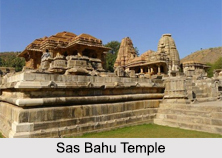 Nagda is located at a distance of 23 kilometers from Udaipur in Rajasthan. During the Rajput reign, this place was known as Nagahrida or Nagadraha. The town was founded in the 6th century by Nagaditya of Guhilot. Nagda is a historically important city as it was the capital of ancient Mewar. But from 1222 to 1229 the town was plundered by Muslim invader, Altamash. Due to these invasions, the town is almost in ruins. Once, several Hindu and Jain temples were located there, but now all the shrines are in ruins.
Nagda is located at a distance of 23 kilometers from Udaipur in Rajasthan. During the Rajput reign, this place was known as Nagahrida or Nagadraha. The town was founded in the 6th century by Nagaditya of Guhilot. Nagda is a historically important city as it was the capital of ancient Mewar. But from 1222 to 1229 the town was plundered by Muslim invader, Altamash. Due to these invasions, the town is almost in ruins. Once, several Hindu and Jain temples were located there, but now all the shrines are in ruins.
Visiting Places in Nagda
The local attraction here includes mostly two temples that have survived the ravages of time - Sas Bahu Temple and Jain Temple. People often visit these temples to seek blessings from the deities-
Sas Bahu Temple: It was built in the 11th century. This temple is well known for its architecture. The intricately carved temple has two shrines - one belongs to Sas or the mother-in-law and the other to the Bahu or daughter-in-law. The entire temple is decorated with beautifully carved figures and other sculptures. The main entrance of the temple is through a doorway, which is decorated with carved lintels and a multi-lobed arch right at the centre. The walls of the shrine are generally plain with no heavy work on it. The sculptures are exquisite, which have been made in two ways - one encircling the other. On the first step, there are images of Lord Brahma, Shiva and Vishnu and on the other, there are images of Rama, Balarama and Parashurama.
Jain Temple: Another temple that captures the attention of the tourists is the Jain temple. This temple is dedicated to the Jain Saint Shanti Nath and it is said to have been built during the rule of Rana Kumbha. The idol of the temple is quite strange from where the temple has derived its name (Advut meaning strange); the idol is 9 feet in height. These temples were destroyed by the foreign invaders to a large extent, still they boast of their exceptional architecture.
Visiting Information to Nagda
Maharana Pratap Airport is the nearest airport and Nagda Junction Railway Station is the nearest rail station to Nagda.



















